If you’re planning to camp in Chiricahua National Monument, you’ll find dramatic rock formations, quiet night skies, and a mix of developed and dispersed options that reward a bit of planning. Know the road and weather quirks, pack for heat and sudden storms, and choose between the small family sites at Bonita Canyon or more remote Forest Service spots. There’s practical camping strategy ahead to help you make the most of your trip.
Why Chiricahua National Monument Is a Unique Camping Destination
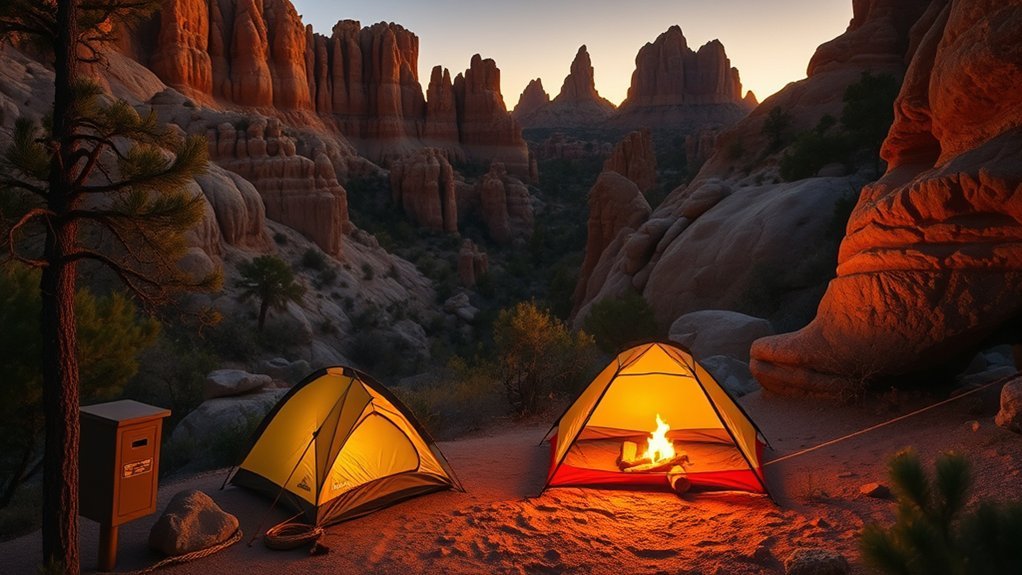
Because Chiricahua National Monument spreads across 12,000 acres of towering pinnacles and balancing rocks, you’ll feel like you’re camping inside “A Wonderland of Rocks.” The Bonita Canyon Campground gives you 25 family sites and a group site with picnic tables, flush toilets, and drinking water, and at $20 a night for standard sites (or $3 per person for the group site) it’s an affordable base for exploring 17 miles of trails where you can spot deer and a variety of birds. You’ll camp amid dramatic volcanic spires that frame sunrise and sunset, making every hike feel cinematic. Trails range from easy loops to steep scrambles, so plan by ability. With year-round access and no entrance fee, you can visit anytime to photograph formations, watch wildlife, and sleep under a sky that complements the monument’s unique geology.
Getting There and Road Conditions to Know
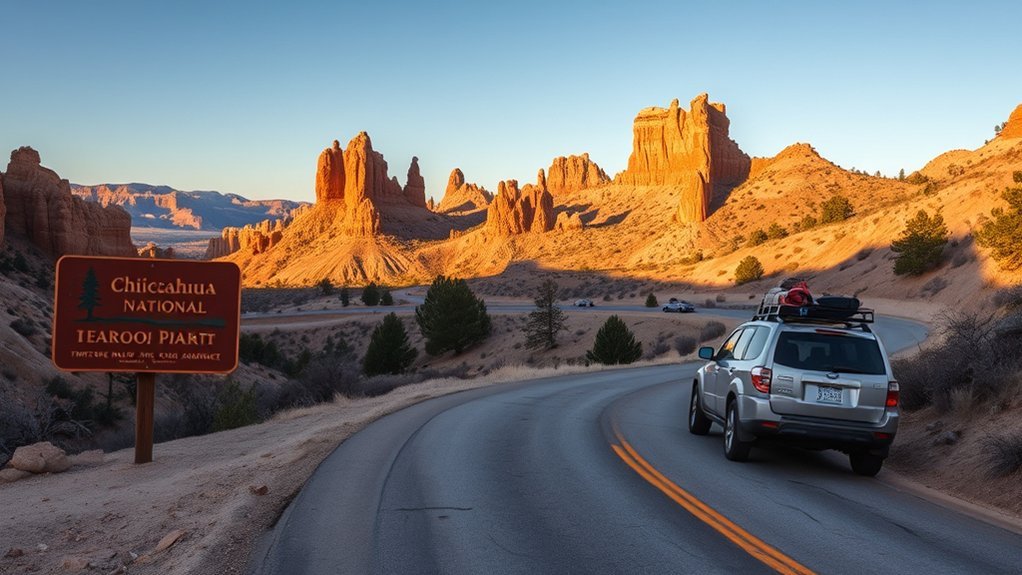
If you’re driving to Chiricahua National Monument from Tucson or Phoenix, plan for about a 1.5–2.5 hour trip to the park’s entrance near Willcox and check Arizona State Route 181 for construction-related detours or closures before you leave. You’ll find the closest town, Willcox, about 37 miles from the monument—stop there to fuel, buy supplies, and confirm directions. Major highways get you close, but once you turn onto smaller roads, road conditions change quickly. Dirt spurs to dispersed sites like Pinery Canyon Road and West Hunt Road can be slick after rain; high-clearance or four-wheel drive helps. Bonita Canyon Campground is accessible by paved park roads, but remember there are no utility hook-ups. Drive prepared, monitor conditions, and allow extra time.
Bonita Canyon Campground: Sites, Amenities, and Reservations
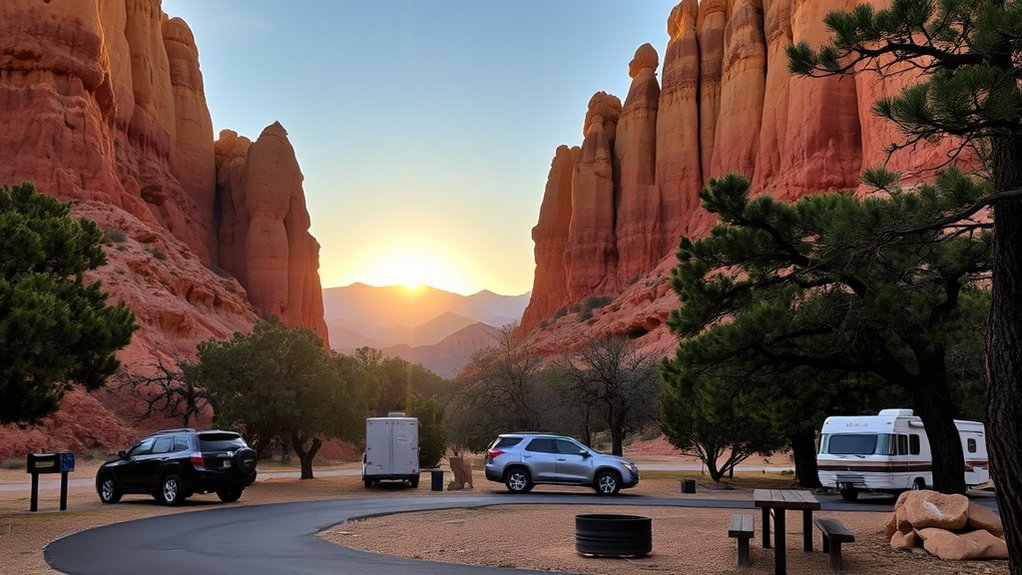
When you set up at Bonita Canyon Campground, you’ll find 25 family sites and a single group site—individual spots run $20 per night while the group site is $3 per person—and most sites are shaded and built for tent camping (RVs and trailers under 29 feet are allowed). You’ll get a picnic table, access to restrooms with flush toilets and cold sinks, and no showers, so plan accordingly. Bring food containers and use provided bear boxes.
- Bring tent-friendly gear
- Use campground water pumps for drinking
- Store food in bear boxes each night
- Pack out trash or use campground disposal
- Reserve ahead at recreation.gov or try first-come, first-served
Make reservations early in peak season; campsites fill fast.
Group Camping at Site 26: What to Expect
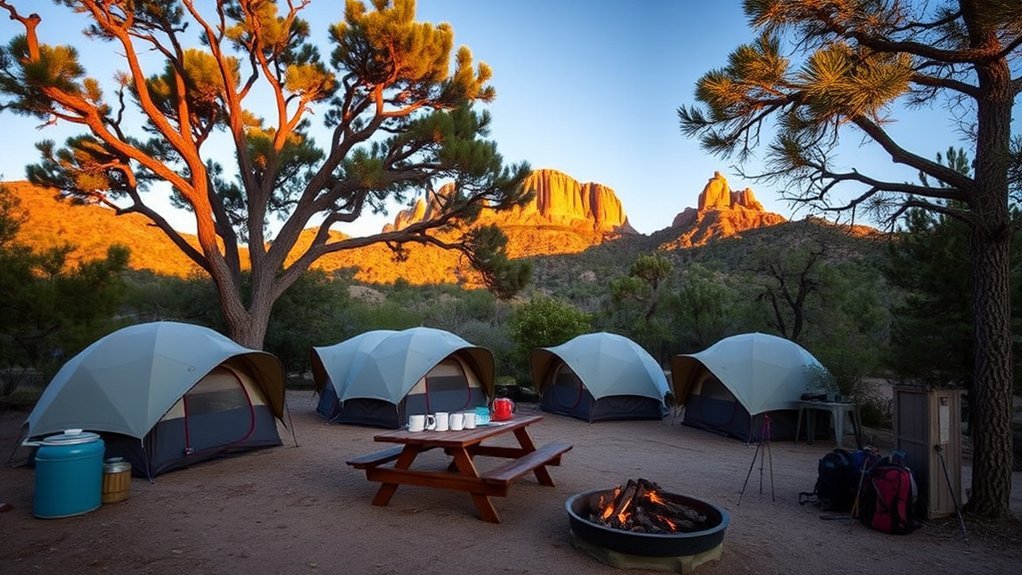
Although it’s set up for larger groups, Site 26 still feels intimate, with six tent pads and space for 8–24 people so you can plan a family reunion, scout trip, or friends’ getaway without everyone cramming into one spot. You’ll find picnic tables, flush toilets, and drinking water at Bonita Canyon Campground, and the $3 per person per night rate keeps costs reasonable. Reserve through recreation.gov ahead of time—Site 26 is popular and often not first-come, first-served. Set up tents on individual pads to maintain personal space, use the shared cooking area thoughtfully, and brief your group on quiet hours and Leave No Trace. After dinner, step away from the tiny lights for excellent stargazing; the Milky Way is often vivid.
Dispersed Camping and Nearby Forest Service Options
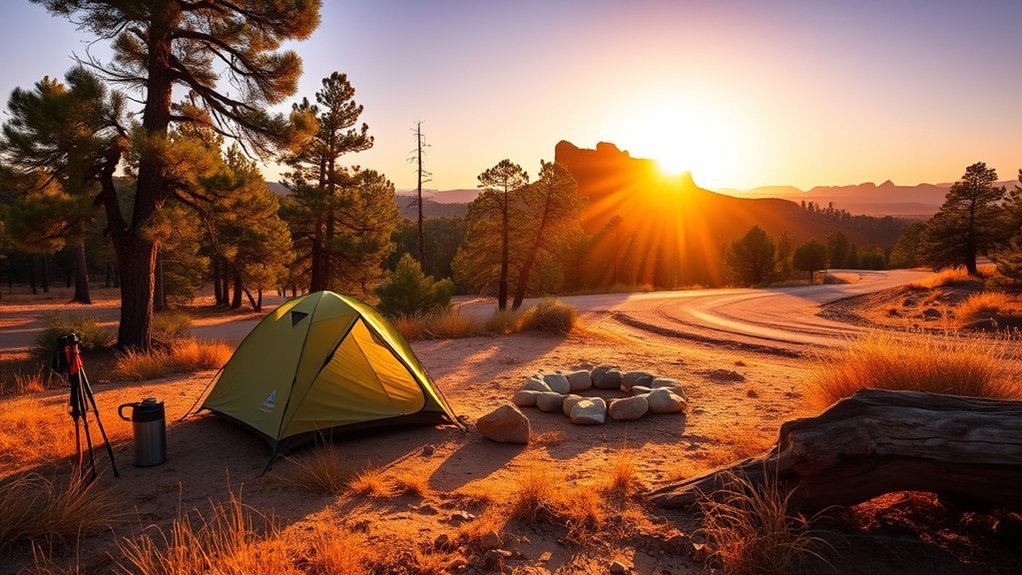
Because the national monument’s developed campground fills up, many visitors choose dispersed camping on nearby Forest Service roads and sites, which give you more solitude and flexibility than Bonita Canyon Campground. You’ll find options a short drive from Chiricahua National: Pinery Canyon Road for shaded tent and RV spots with fire pits; FS Road 42 along a dry creek; Granite Gap for scenic, high-clearance access; John Hand Campground as a basic option; and Happy Camp Trail for boondocking and hiking with a pit toilet. Choose sites based on vehicle capability and desired solitude.
- Check road conditions before you go.
- Pack water; amenities are limited.
- Respect fire regulations and use established pits.
- Camp away from cultural sites.
- Leave no trace; pack out trash.
Weather, Monsoon Risks, and When to Plan Your Trip
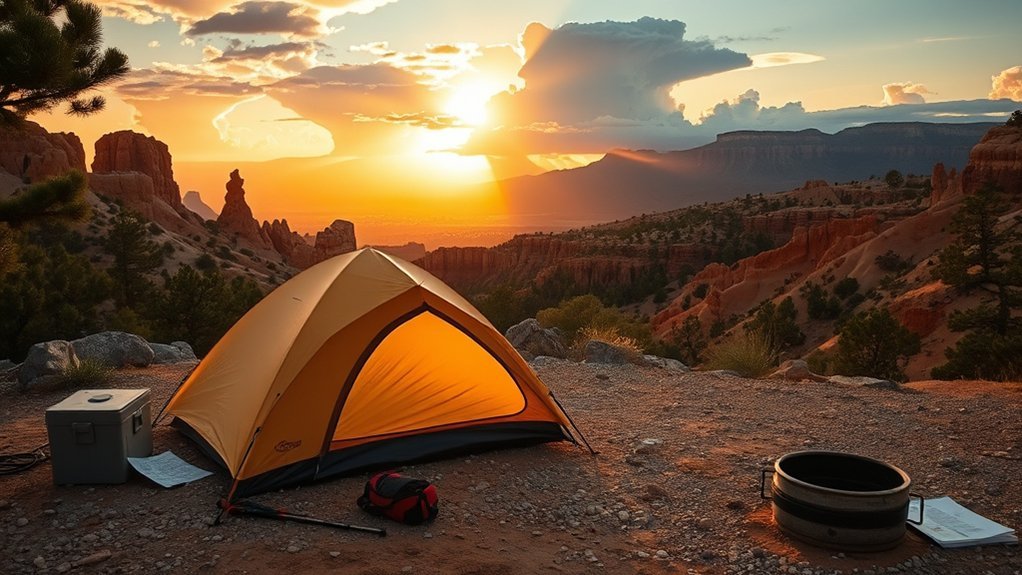
Plan your trip with the Arizona monsoon in mind — late June through mid-September can bring sudden thunderstorms, heavy rain, and even hail. Those storms can cause tent leaks and localized flooding in campground flood zones, so check forecasts and avoid low-lying sites. To beat the heat and reduce storm risk, aim for early-morning hikes and consider visiting in spring or fall for milder conditions.
Monsoon Season Timing
If you visit Chiricahua between late June and mid-September, expect sudden thunderstorms, heavy rain, and afternoon heat that can upend camping and hiking plans; monitor forecasts closely and be ready to adjust schedules. The monsoon season brings quick shifts—plan mornings for hikes, protect your shelter, and watch lower washes for rising water. Use weather forecasts daily and have an exit plan if storms build.
- Start hikes at dawn to avoid heat and afternoon storms.
- Waterproof tents and raise gear off wet ground.
- Avoid low washes and streambeds during storms.
- Check park alerts and radar before leaving camp.
- Have alternate lodging if prolonged heavy rain is predicted.
You’ll likely see more wildlife in cool post-rain evenings; stay observant and safe.
Thunderstorm Hazards
When summer heats build, storms can roll in fast during Arizona’s monsoon—bringing heavy rain, lightning, and occasional hail that can strand campers and flood low-lying sites. You should treat thunderstorms seriously: they produce flash floods and dangerous lightning strikes. Check weather forecasts before you go and again each morning and afternoon; forecasts help you avoid travel into active cells. Know your campsite layout—some areas are official flood zones—so pick higher ground and secure gear if storms threaten. Expect tents to leak in sustained downpours and pack waterproof bags and sturdy rainflies. If lightning is nearby, avoid high ridges, isolated trees, and exposed rock fins. Plan hikes early in the day to reduce storm exposure, and have an exit plan if conditions deteriorate.
Cooler Morning Windows
Because morning temperatures stay cooler and storms are less likely until afternoon, you should aim to get hiking and explore the rock formations early—typically before noon—when trails are more comfortable and lightning risk is lower. Plan around cooler morning temperatures to avoid midday heat and monsoon storms that can produce heavy rain, hail, and lightning. Check weather conditions before and during your trip; forecasts can change quickly in monsoon season. Nights are often cool, so pack layers for sleeping. Choose timing to maximize safety and enjoyment.
- Start hikes before noon
- Monitor forecasts hourly
- Carry lightning-aware gear
- Prepare for soggy ground after rain
- Opt for cooler months if possible
These steps keep hiking safe and comfortable.
Hiking From Camp: Trails, Difficulty, and Timing
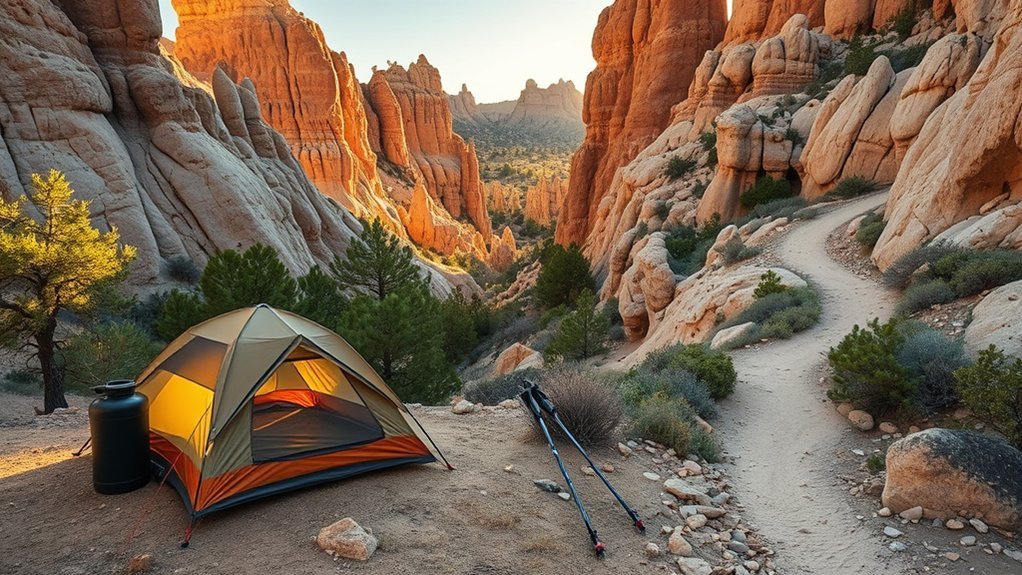
From camp you can pick hikes that match your energy and time, from easy walks to the pet-friendly Silver Spur Meadow to the moderate Echo Canyon Loop’s 3.3 miles of striking rock formations. Plan tougher routes like the Ed Riggs Trail counter-clockwise for easier climbing and better panoramas. Start early — especially in summer — to beat the heat and make the most of daylight.
Trail Difficulty Levels
If you’re camping at Chiricahua, plan your hikes around 17 miles of trails that range from easy family-friendly walks to moderate routes that test your legs and footing. You’ll find clear examples of trail difficulty levels: Silver Spur Meadow is an easy 1.2-mile walk to Stafford Cabin, while Echo Canyon Loop is a moderate 3.3-mile route with rewarding views if you hike it counter-clockwise. Check current conditions on the National Park Service site before you go.
- Know the distance and elevation change
- Match route choice to your fitness and experience
- Start early to beat summer heat
- Wear proper shoes for loose rock and steps
- Carry water and a map for changing conditions
These hiking trails balance scenery and effort, so pick wisely.
Best Times to Hike
When you’re camping at Chiricahua, plan hikes for early morning or late afternoon to avoid the midday heat and catch the best light on the rock formations. You’ll find the best times to hike in Chiricahua National Monument are cooler hours, especially in summer; check the National Park Service for trail updates. Echo Canyon Loop (3.3 mi) is moderate and rewarding at dawn. Silver Spur Meadow Trail (1.2 mi) to Stafford Cabin is ideal for families in the evening. Watch weather—monsoon storms can arrive quickly—carry water, layers, and a map.
| Trail | Distance | Best Time |
|---|---|---|
| Echo Canyon Loop | 3.3 mi | Early morning |
| Silver Spur Meadow | 1.2 mi | Late afternoon |
| Park Alerts | — | Check NPS site |
Wildlife, Pets, and Safety Precautions
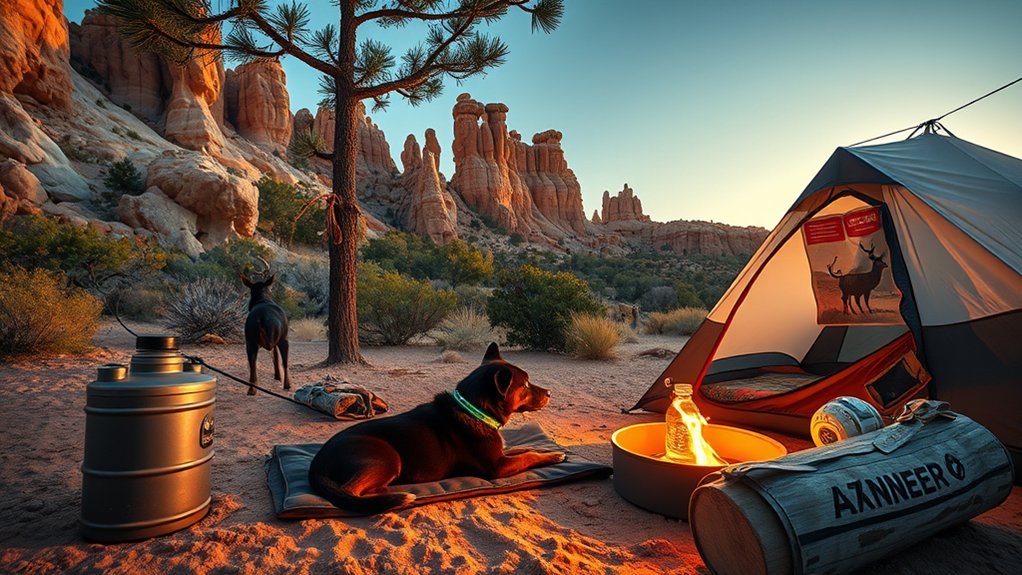
Because Chiricahua supports an abundance of wildlife — 71 mammals, 46 reptiles, and 171 birds — you should stay alert and respect animals’ space while camping. Observe wildlife from a distance, secure food properly, and know that wildlife,pets,safety precautions go hand in hand here. Pets are allowed only in designated areas (Bonita Canyon Campground, Faraway Ranch, certain trails) and must be leashed.
- Keep pets leashed and supervised at all times.
- Don’t feed or approach wild animals; use bear boxes for food.
- Check with the park about flood-prone campsite areas before setup.
- Never leave pets or people in vehicles during hot weather (Arizona Samaritan Hot Car Law).
- Monitor weather forecasts and move if conditions threaten safety.
Follow rules, stay aware, and you’ll minimize risks and enjoy the monument safely.
Packing Essentials and Camp Setup Tips (Water, Shelter, and Food)
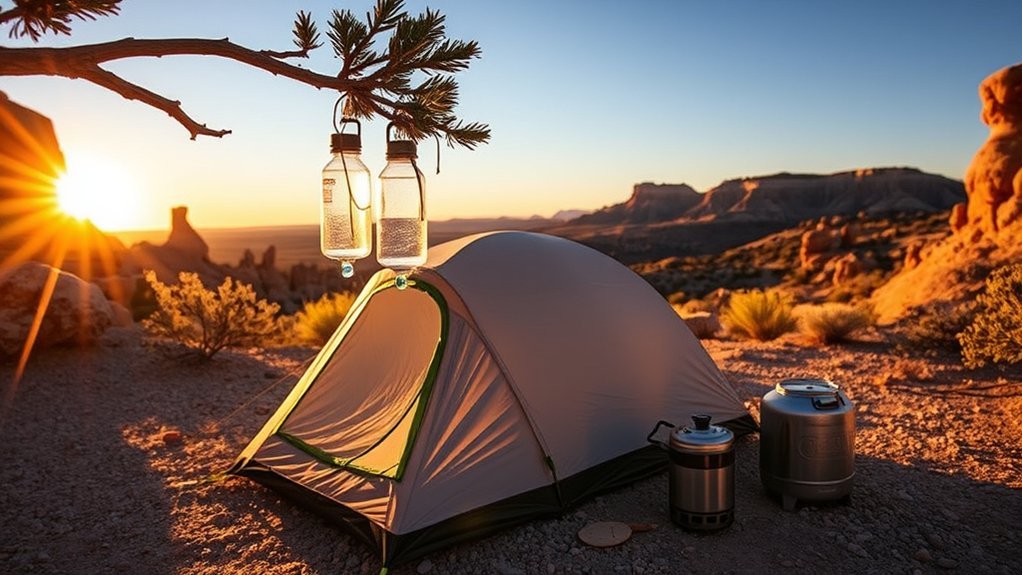
Bring plenty of water and use it carefully since potable taps are only at campground pumps and there’s no food service in the park. Pick a weatherproof shelter and test seams and rainflyes before storms, because tent pads are provided but leaks can happen in the monsoon. Pack nonperishable meals, store everything in the provided bear boxes, and plan to cook with a camp stove or campfire since there’s no electricity or ice.
Water: Carry & Conserve
If you’re heading into Chiricahua’s heat, plan and pack for at least one gallon of water per person per day for drinking and cooking, and carry extra for hikes. You’ll find campground pumps, but don’t rely on them for long outings. Carry a durable container, refill at pumps, and practice simple ways to conserve water so you won’t run low.
- Carry at least one gallon per person per day
- Refill at campground pumps before setting out
- Use biodegradable soap and minimal water for dishes
- Store food and toiletries in bear boxes to avoid spills
- Camp at least 200 feet from natural water sources to protect them
Conserve water by rinsing items once and using collapsible jugs for efficient transport.
Shelter: Weatherproof Your Site
When storms roll in during monsoon season, you’ll want a tent with a full rainfly and taped seams and a sturdy tarp to shed heavy rain and hail; set up on higher ground — not in low spots or wash paths — to avoid flash flooding and keep your gear dry. Pick a tent rated for waterproofing and pitch it taut to shed wind-driven rain. Lay a ground tarp under the footprint, and bring an overhead tarp to expand covered living space. At the campground, use provided bear boxes for food and toiletries to avoid critters and reduce night traffic to your site. Carry a reliable water filter or purification tablets since drinking water is available only at campground pumps, not dispersed sites.
Food: Safe Storage Practices
Because wildlife is persistent, make safe food storage a top priority at Bonita Canyon Campground: pack all edibles and toiletries in airtight containers to lock in odors, and stow them in the provided bear boxes rather than in your tent or vehicle. You’ll cook with a camp stove or gas—check fire regulations first—and keep food prep well away from sleeping areas. Collect drinking water from campground pumps and seal it in clean containers. Follow these quick rules to minimize wildlife visits and protect gear.
- Store all food and toiletries in bear boxes
- Use airtight containers for odor control
- Cook with stoves; avoid open fires when restricted
- Keep water sealed and sanitary
- Separate cooking and sleeping areas to reduce wildlife encounters
Permits, Fees, Rules, and Leave No Trace Practices
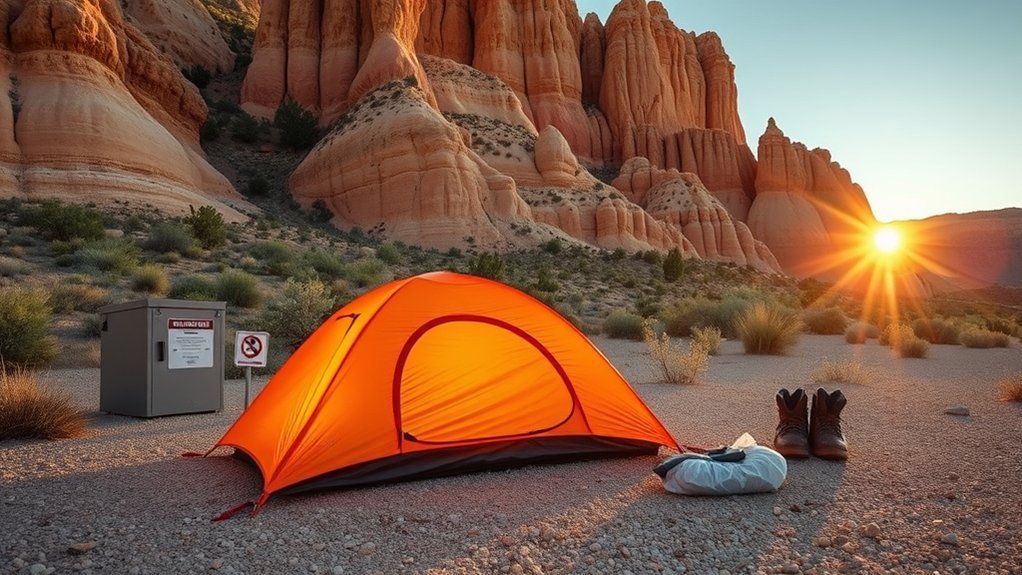
Plan ahead and pay attention to fees and rules so your campsite stay in Chiricahua is smooth and responsible. You don’t need an entrance permit, but camping permits and reservations are required: standard sites are $20/night, group sites $3/person, bookable at recreation.gov. Stay only in designated spots in Bonita Canyon Campground and note some sites close during monsoon season. Maximum consecutive stay is 14 nights.
Follow Leave No Trace practices: pack out all trash, bury human waste only where allowed, minimize campfire impact, and secure food in provided bear boxes to protect wildlife. Pets are allowed in limited areas and must be leashed. Check weather forecasts—low-lying areas can flood—and adjust plans accordingly.
Frequently Asked Questions
What Is the Best Time of Year to Visit Chiricahua National Monument?
Spring and fall are the best times to visit Chiricahua National Monument; you’ll enjoy spring blooms, more wildlife sightings, and manageable temperature variations, so you can hike comfortably and photograph scenery without extreme heat or monsoon storms.
What Is the Difference Between Camping and Backcountry Camping?
Camping means you use car camping essentials at developed sites with amenities and social norms; backcountry camping needs lightweight backcountry gear, self-sufficiency and stricter campsite etiquette, so you’ll plan, pack, and minimize your impact.
Can You Camp in the Chiricahua Mountains?
Yes — you can camp in the Chiricahua mountains. You’ll find Chiricahua camping at Bonita Canyon and dispersed sites; campsite amenities are limited, so bring supplies, expect wildlife encounters, and follow local rules and seasonal conditions.
Are There Hiking Trails in Chiricahua?
Want dramatic hoodoos and quiet meadows? You’ll find diverse hiking routes with varying trail difficulty—easy Silver Spur to moderate Echo Canyon—offering stunning scenic views; you’ll experience rewarding hikes suited to your pace and interests.
Conclusion
By camping in Chiricahua, you’ll feel like you’ve stumbled into a stone cathedral where every sunrise stages a jaw-dropping performance. Stick to Bonita Canyon or disperse wisely, hike early to dodge thunderstorms, and pack water, weatherproof shelter, and bear-safe food like your life depends on it — because it kinda does out here. Follow permits, campsite rules, and Leave No Trace, and you’ll leave the monument magically intact and your stories outrageously brag-worthy.

